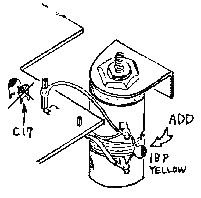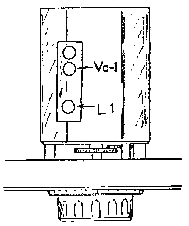VFO drift characteristics may be improved by changing a capacitor value and location in the VFO.
- Begin by calibrating the analog dial to the Digital Display at 14.000.0 MHz. DO NOT disturb this calibration while working on the VFO.
- Turn off the main power and remove the VFO unit by two 3mm hex head bolts.
- Withdraw out the front panel and unplug the leads.
- Remove the VFO cover by five Phillips head screws.
- Remove C17 from the PCB. This may be cut flush to the board.
- Install the 18 pF yellow cap across the tank coil terminals. Position the cap near the coil.
- To reassemble, performs steps 3, 2. Snug all VFO case screws. A later complaint of frequency jump would indicate a loose VFO shell.
- Turn on the radio and check analog dial calibration against the Digital Display. Adjust VC1 (center of the Seal Tape) only if the zero-point has moved.
- VFO linearity final check: The Digital readout and analog dial should agree to within +/- 2 kHz at every 100 kHz dial point.
New Part: 18 pF CC45RC1H180J
Old Part: 18 pF CC45PG1H180J |
 |
Analog Dial Calibration
- Calibrate the main knob to 50 kHz analog against the digital display.
- Note the digital error. If it is more than 2 kHz adjust the VFO trimmer cap VC1 (center under the sealing tape) to exactly 50.0 on the digital readout.
- Turn the main knob to 450 analog. If the digital error is less than 2 kHz it is in spec. If the digital error greater, proceed:
For instance, if the digital error is 14.454.0 (plus 4 kHz), multiply the error times 4 (16 kHz) and adjust the VFO trimmer cap to the desired frequency (14.450.0) LESS the error, or 14.434.0. Next, adjust the VFO inductor L1 (front under the sealing tape) back up to the desired frequency of 14.450.0.
- If the error in step 3 was in the minus direction, reverse the direction of correction adjustment.
- VFO linearity final check: The digital readout and analog dial should agree to within +/- 2 kHz at every 100 kHz dial point.

|
